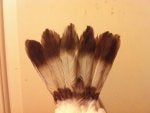Part of the problem with not getting more replies, is that "tail patterns" are generally not named. In pigeon genetics, pattern names are generally used to describe the bird and specifically the pattern on the wing shield. Because your birds are predominantly white, a genetic factor such as one or more of the "pied" genes covers up the true pattern on the wing shields and therefore, the patterns cannot be seen or identified. That is why on genetic websites, it is often suggested to mate a bird with unknown or unidentifiable genetic factors with a blue-bar. The theory being that many of the genetic factors will be revealed in the offspring when mated to a bird without a bunch of complicating modifying factors itself.
Jim









